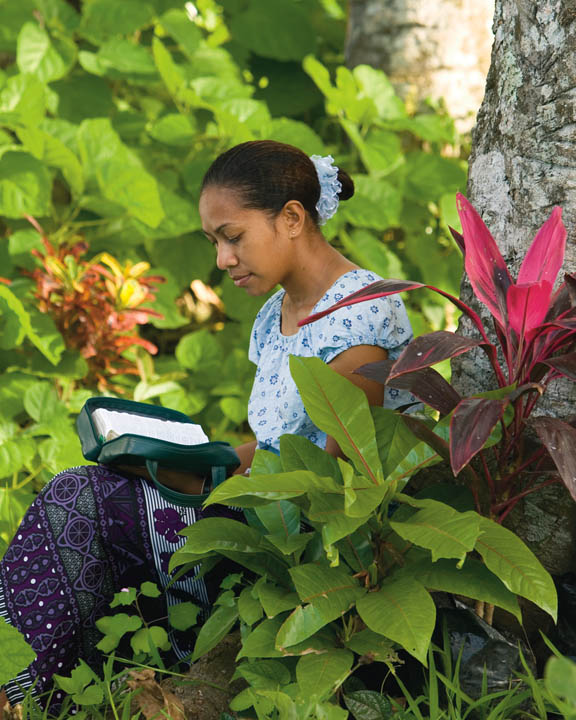Mormons—a nickname for members of The Church of Jesus Christ of Latter-day Saints—have a number of special programs for teenagers who are twelve to seventeen years old. These programs teach them about their faith and give them opportunities to put what they learn into practice. They also learn many practical skills that prepare them to be successful adults in their communities, their careers, and their homes.
Sunday services are three hours long. The main worship service, called Sacrament Meeting, is just over one hour. Since the Mormons have a lay church, they do not have a paid minister. Instead, a bishop, similar to a lay pastor, is chosen from among the men in the congregation. He generally has secular employment and a family, so his church work is completed in the evenings and on weekends. This means the work that might normally be done by a full-time paid employee must be divided among many people, including the teenagers.
 The bishop does not give the sermon each week. He and two counselors take turns conducting the service, but the prayers and sermons (called talks) are given by ordinary church members. Most Mormons speak about once a year and each service includes two or three speakers. Teenagers can begin giving talks at age twelve. By this time, they have had considerable experience, since they have been giving 2 ½ minute talks in the children’s Primary since age three. As teens, they speak in the regular adult service for about five minutes. When they are adults, they will speak for ten to twenty minutes, depending on the number of speakers.
The bishop does not give the sermon each week. He and two counselors take turns conducting the service, but the prayers and sermons (called talks) are given by ordinary church members. Most Mormons speak about once a year and each service includes two or three speakers. Teenagers can begin giving talks at age twelve. By this time, they have had considerable experience, since they have been giving 2 ½ minute talks in the children’s Primary since age three. As teens, they speak in the regular adult service for about five minutes. When they are adults, they will speak for ten to twenty minutes, depending on the number of speakers.
The sacrament, similar to communion, is prepared, blessed (prayed over) and handed out to the membership by teenage boys who hold the priesthood if there are enough of them. If there are not, adults assist. Teen boys can receive the priesthood at age twelve, which is different from being a priest in other churches. It gives them the opportunity to serve God in increasingly more responsible positions, but priesthood is strictly a service opportunity. They cannot use their priesthood to bless themselves, only others. Having this opportunity means they are expected to be more mature and responsible than most teenagers, not just at church, but always.
Mormon teens attend two classes each Sunday with their own peers. Sunday School is for both boys and girls, and, when there are enough teens, they divide into several classes based on age. Boys also attend a priesthood class and girls attend a comparable class called Young Women’s. In this class they learn how to put their religious knowledge into their real lives.
During the week, teens meet one evening a week, with the boys participating in Scouting or their Young Men’s program, and the girls participating in a church-created Young Women’s programs. They have combined meetings once a month. During this time, the boys work to earn their Scouting badges while the girls work on the requirements for a unique Personal Progress program. Both programs give them opportunities for hands-on application of gospel principles and teach them to set and meet intense goals. Both programs require extensive community service.
The Mormon youth lead their own programs with shadow leadership from the adult leaders. This means the adults mentor and guide, but do not take over. For instance, when the youth are planning an activity, the adults might ask questions that cause the teens to think about whether or not the activity will meet a goal, improve lives, and honor church standards, but they won’t tell them whether or not it will. Eventually, the teens learn to carry out their programs with less guidance. In the meantime, they are trained in leadership skills and learn to work with adults and peers both. They learn to plan, carry out, conduct, and evaluate activities and meetings, learn to lead music, speak in public, and serve others. The youth leaders, who are chosen by adults and who are rotated often, learn to put the needs of their organization before their own and to pay attention to which teens might be lonely, who has special needs, and how they can create activities that are both meaningful and fun.
Each school day, Mormon youth attend a religion class in which they study the scriptures in-depth for four years. They study the Bible for two of these years, the Book of Mormon for one, and the Doctrine and Covenants for one. The study is in-depth and, while spiritual, is also more academic than Sunday School.
These programs help to explain why Mormon youth were found in a non-Mormon study of religious teens to be better able to discuss their religious beliefs than other religious teens and also to have a greater personal commitment to their faith than other teens. They are designed not just get teens to show up in order to be entertained, but to teach them to be responsible, participating members of their faith.
